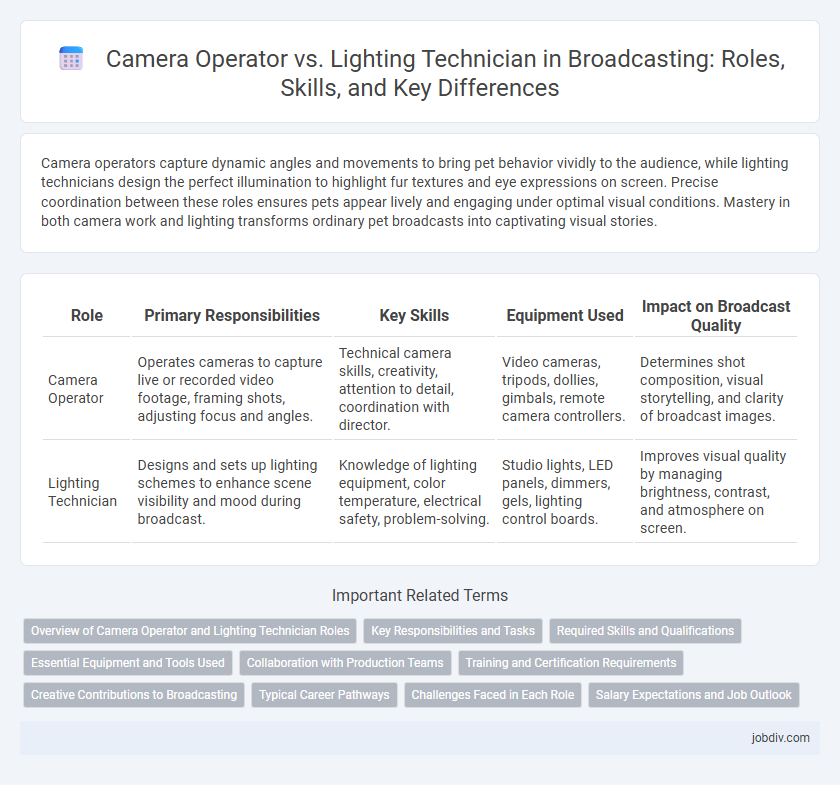Camera operators capture dynamic angles and movements to bring pet behavior vividly to the audience, while lighting technicians design the perfect illumination to highlight fur textures and eye expressions on screen. Precise coordination between these roles ensures pets appear lively and engaging under optimal visual conditions. Mastery in both camera work and lighting transforms ordinary pet broadcasts into captivating visual stories.
Table of Comparison
| Role | Primary Responsibilities | Key Skills | Equipment Used | Impact on Broadcast Quality |
|---|---|---|---|---|
| Camera Operator | Operates cameras to capture live or recorded video footage, framing shots, adjusting focus and angles. | Technical camera skills, creativity, attention to detail, coordination with director. | Video cameras, tripods, dollies, gimbals, remote camera controllers. | Determines shot composition, visual storytelling, and clarity of broadcast images. |
| Lighting Technician | Designs and sets up lighting schemes to enhance scene visibility and mood during broadcast. | Knowledge of lighting equipment, color temperature, electrical safety, problem-solving. | Studio lights, LED panels, dimmers, gels, lighting control boards. | Improves visual quality by managing brightness, contrast, and atmosphere on screen. |
Overview of Camera Operator and Lighting Technician Roles
Camera Operators are responsible for capturing high-quality video footage by skillfully managing camera equipment, framing shots, and adjusting angles to align with the director's vision. Lighting Technicians design and implement lighting setups that enhance visual aesthetics, control shadows, and ensure consistent illumination tailored to the scene's mood. Both roles are essential in broadcasting production, with Camera Operators focusing on image capture and Lighting Technicians optimizing the visual environment for the camera.
Key Responsibilities and Tasks
Camera operators manage the camera equipment to capture high-quality footage, ensuring proper framing, focus, and movement to align with the director's vision. Lighting technicians design and set up lighting systems to enhance scene mood, control shadows, and maintain consistent illumination for optimal visual effects. Both roles require technical expertise but differ, as camera operators concentrate on capturing images while lighting technicians manipulate light to improve image quality.
Required Skills and Qualifications
Camera operators must have expertise in framing, focusing, and adjusting camera settings to capture high-quality footage, along with proficiency in various camera equipment and software. Lighting technicians require a strong understanding of lighting design, color temperature, electrical systems, and the ability to operate and maintain lighting rigs to create optimal visual effects. Both roles demand technical proficiency, attention to detail, and effective communication skills to collaborate within a production team.
Essential Equipment and Tools Used
Camera operators rely on high-definition cameras, tripods, sliders, and gimbals to capture smooth, stable footage, often using follow focus systems and wireless video transmitters to maintain precision and control. Lighting technicians utilize a range of essential tools including LED panels, Fresnel lights, diffusers, gels, and control boards to manipulate light intensity, color temperature, and shadows for optimal scene illumination. Both roles depend on specialized equipment tailored to their technical needs, with camera operators focusing on image capture and movement, while lighting technicians prioritize scene ambiance and visibility.
Collaboration with Production Teams
Camera Operators and Lighting Technicians work closely with production teams to ensure visual storytelling is flawless and lighting complements camera angles. Effective collaboration involves synchronizing camera movements with lighting setups to achieve desired moods and clarity in every shot. Their combined expertise enhances overall production quality, maintaining consistency across scenes.
Training and Certification Requirements
Camera operators typically require training in camera mechanics, framing, and movement, often obtained through film or broadcasting programs, with certifications like the Society of Broadcast Engineers (SBE) Certified Camera Operator enhancing job prospects. Lighting technicians focus on electrical wiring, light design, and equipment safety, gaining expertise through vocational courses or apprenticeships, accompanied by certifications such as OSHA safety training or Entertainment Technician Certification Program (ETCP). Both roles demand a strong understanding of industry standards and safety protocols to ensure efficient, high-quality production results.
Creative Contributions to Broadcasting
Camera operators shape the visual storytelling by framing shots, adjusting angles, and capturing dynamic movement that enhances narrative engagement. Lighting technicians manipulate light intensity, color, and direction to establish mood, depth, and atmosphere essential for the broadcast's emotional impact. Both roles collaborate to create visually compelling broadcasts that effectively convey the intended message to audiences.
Typical Career Pathways
Camera operators typically begin their careers as production assistants or camera assistants, gradually gaining experience with various camera equipment and shot composition before advancing to lead camera roles on larger productions. Lighting technicians often start as grips or electrics, learning to manage lighting setups, electrical wiring, and lighting design, progressively moving up to chief lighting technician (gaffer) positions in film, television, or live events. Both career pathways emphasize hands-on experience, technical skill development, and collaboration with directors and production teams to enhance visual storytelling quality.
Challenges Faced in Each Role
Camera operators face challenges such as maintaining precise framing and focus while adapting to dynamic scenes and fast-paced movements. Lighting technicians encounter difficulties managing complex lighting setups, ensuring consistent illumination, and balancing light sources to avoid unwanted shadows or glare. Both roles require technical expertise and quick problem-solving skills to deliver high-quality broadcast visuals.
Salary Expectations and Job Outlook
Camera operators in broadcasting typically earn an average salary ranging from $40,000 to $70,000 annually, with demand driven by live event coverage and studio productions. Lighting technicians earn slightly less on average, between $35,000 and $60,000 per year, benefiting from steady opportunities in film, television, and theater lighting. Job outlook for both roles remains positive, with advancements in digital media and growing content production fueling consistent employment growth.
Camera Operator vs Lighting Technician Infographic

 jobdiv.com
jobdiv.com